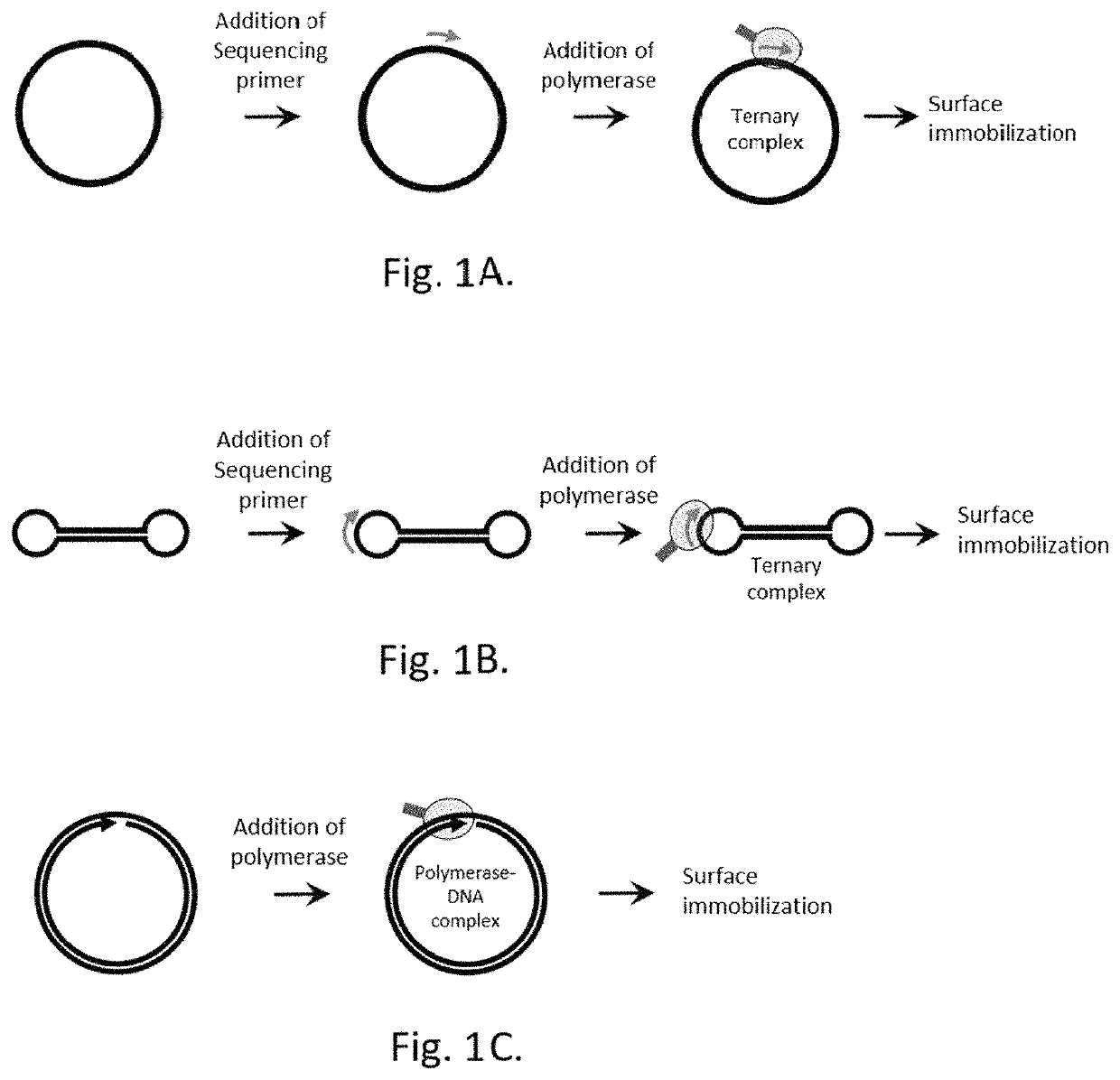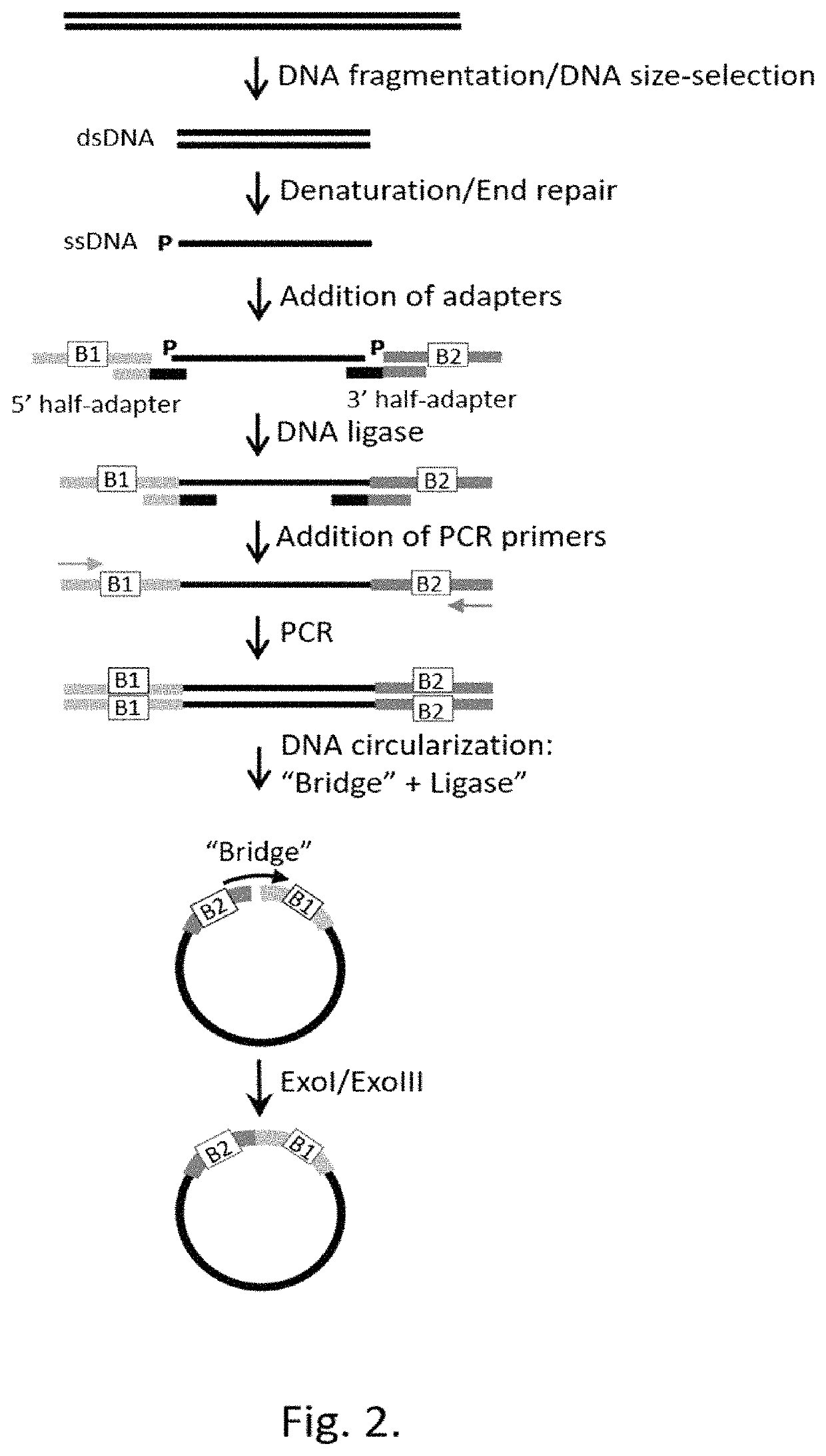Method for label-free single-molecule DNA sequencing and device for implementing same
a single-molecule, label-free technology, applied in the direction of biochemistry apparatus and processes, fluid controllers, laboratory glassware, etc., can solve the problems of high cost of fluorescently-labeled terminator nucleotides, limited sequencing speed, read length, etc., to achieve low cost, low reagent consumption, and low cost
- Summary
- Abstract
- Description
- Claims
- Application Information
AI Technical Summary
Benefits of technology
Problems solved by technology
Method used
Image
Examples
example 1
ircle Replication (RCR) by Ternary Complex “Polymerase-Primer-Template DNA” Works on the Solid Surface of the Sensor
[0220]To construct a single-stranded circular DNA template for the DNA synthesis by Phi29 polymerase, 10 ng of Ultramer oligonucleotide with the length of 177 nt (Integrated DNA Technologies Inc., USA) was used as a template for PCR. Reaction was carried out in the reaction mixture in 50 μl volume containing 2×Q5 Polymerase mix (New England Biolabs, Inc., USA), a template, and 500 nM of forward and reverse PCR primers.
[0221]Thermocycling was carried out under the following conditions: 98° C. for 30 seconds; then 30 cycles—98° C. 10 sec, 58° C. 30 sec, 72° C. 40 sec; further 72° C. for 2 minutes. On completion of PCR the double stranded DNA products were purified using a DNA purification kit and eluted with 50 μl of 50 mM Tris pH 8.0.
[0222]2 pmoles of PCR product were mixed with 100 nM of “bridge”-oligonucleotide, denatured by heating for 3 minutes at 95° C., followed b...
example 2
onductor Sensor and Circuit of Cell Array Fabricated by Semiconductor CMOS Technology
[0227]Examples of possible designs of the sensor cell shown in FIG. 12-14, 16, 17, including the scheme, realizing the function of stochastic resonance shown in FIG. 15.
[0228]The polymerization reaction of a DNA fragment of polymerase complex 19, 25, 31, 38, immobilized on the cell surface of the sensor, due to the interaction of the polymerase with the reagents of the reaction mixture 22, 28, 34, 41, is accompanied by the separation and localization of negative charge (electron) and the free proton in proximity of the activated segment of DNA fragment. Thus, the result of the reaction is the generation of a pair of electron-proton, followed by localization of electron on activated segment of the DNA fragment and the drift of a proton in an aqueous solution of the reaction mixture in an electric field of the cell in the direction of the bias electrode 23, 29, 35, 42, which is connected to source vol...
example 3
Sensor Based on Nanowire FET
[0257]Nanoscale sensor based on nanowire field effect transistor designed to record the results of splitting up pairs of charges near the sensor surface after each incorporation of nucleotides by polymerase into the polymerized DNA fragment in composition with the immobilized polymerase complex at the surface of the nanowire 44.
[0258]The block diagram of the nanowire transistor with immobilized triple complex is shown in FIG. 16, and consists of a planar thin film metal nanostructures deposited on the dielectric layer 49, covering substrate 45; thin film metal electrode nanostructure (contacts to the nanowire) 46 together with the metal channel-nanowire 50 is formed on a dielectric substrate by photo- and electron lithography with using photo- and electronic resist, also as with technology of etching exposed areas and technologies of metal sputtering by the magnetron or thermal method.
[0259]The control electrode can also serve as a conductive sublayer (fo...
PUM
| Property | Measurement | Unit |
|---|---|---|
| diameter | aaaaa | aaaaa |
| thick | aaaaa | aaaaa |
| thick | aaaaa | aaaaa |
Abstract
Description
Claims
Application Information
 Login to View More
Login to View More - R&D
- Intellectual Property
- Life Sciences
- Materials
- Tech Scout
- Unparalleled Data Quality
- Higher Quality Content
- 60% Fewer Hallucinations
Browse by: Latest US Patents, China's latest patents, Technical Efficacy Thesaurus, Application Domain, Technology Topic, Popular Technical Reports.
© 2025 PatSnap. All rights reserved.Legal|Privacy policy|Modern Slavery Act Transparency Statement|Sitemap|About US| Contact US: help@patsnap.com



